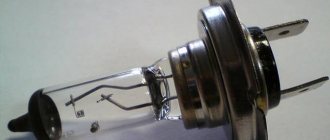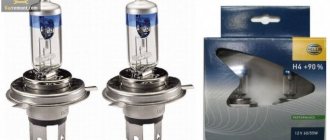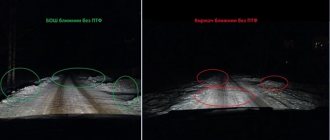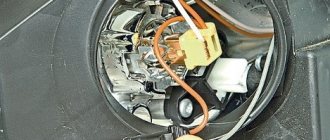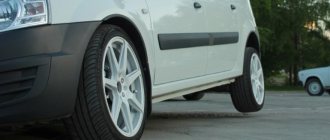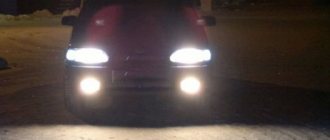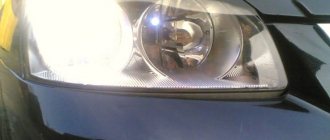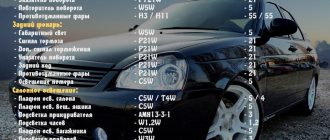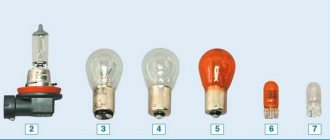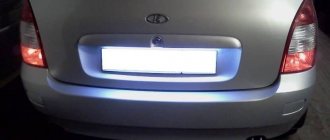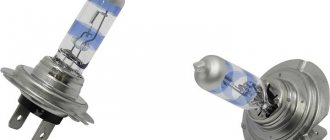Installing a PTF is not a mandatory procedure. But fog lights often provide a good service to the driver, improving the quality of headlights. The low location of the lamps, illuminating only the road surface, and the color spectrum allow the driver to clearly see the route in heavy fog. The design of the light bulb in the PTF is similar to a regular one, but it shines in parallel. Correctly selected fog lamp bulbs guarantee high-quality illumination on the road, economical use of electricity and a long service life.
What kind of lamps are in fog lights - selection rules
Lamps in PTF, unlike the main road lighting, should provide illumination in poor weather and visibility conditions. The peculiarity of this light is that the radiation is not reflected from drops of moisture in the air and does not blind the driver. And although the factory installation of foglights is not provided for on all brands of cars, there is hardly a car enthusiast who will voluntarily give up such functionality.
What are fog lights
Fog lights (FTL) are used on vehicles and usually operate in the white or selected yellow spectrum. The wide, flat horizontal beam of the headlights extends above the road, improving illumination of the road surface and visibility of the roadside. PTFs are located below the headlights, but there are also options with a location in the head optics.
Lamps in PTF
PTF device
The design of the fog lamp emitter is similar to the design of day and night road lighting. The standard PTF has:
- base with lamp socket;
- deflector for reflecting and directing light;
- emitter;
- diffuser
But the distinctive features are that the PTF directs the light flux parallel to the road surface, this provides additional range and does not blind oncoming drivers. Therefore, bulbs for fog lights are installed below the main lighting.
What lamps are used
An anti-fog lamp, regardless of the type of emitter, must have the following characteristics:
- The color temperature indicator is 2500–3200 K. It gives a warm yellowish tint, which has a greater range compared to cold radiation.
- The range of the beam and the formation of a clear light beam, which should not be scattered by refracting through drops of moisture in the air.
Now the most common are halogen, xenon and LED types of emitters for fog lights.
- Halogen. In the standard factory equipment of the car, halogen lamps are installed in the PTF by default. They have an average service life (about 150–250 hours or 2–4 years). Halogen fog lights produce a yellowish or orange tint, which may not be enough for comfortable driving.
- Improved halogen. Each brand has its own models that either provide brighter, whiter light or longer lifespan. Such illuminators contain a more saturated gas mixture in the bulb, which increases the color temperature.
- Xenon or gas-discharge fog lamps. Such illuminators cannot be installed on every car. Xenon has a very bright light beam and can blind oncoming traffic. Therefore, the use of gas-discharge lamps must comply with GOST requirements, otherwise you may receive a fine.
Often, such a headlamp produces cold radiation, which is more scattered by fog or precipitation than neutral or yellowish light. But the advantages of gas-discharge lamps include their low energy consumption and high light output. At the same time, the service life of xenon is at least 3 years.
- LEDs. They have the highest efficiency with low power consumption. At the same time, the light temperature is closest to natural daylight and has a neutral range. The light beam is bright and has a clear contour (the radiation is not scattered due to fog, snow or rain).
The service life of the diodes is more than 20,000 hours. But their installation is not possible on all brands. To cool the lamp, you need to install a system that may not fit into a standard headlight housing. Therefore, before purchasing, check the possibility of installing LED fog lights on your car.
We recommend videos on the topic:
How to choose lamps for fog lights
Fog lights are not standard on many vehicles. Despite this, this option is simply necessary when driving in poor visibility conditions. The low location of these lamps allows illumination of the road surface area without reflecting or scattering light.
Every driver who has driven a car in foggy conditions understands the value and importance of additional lighting in such situations. At the same time, its quality, efficiency, and durability directly depend on the light bulbs, so their choice should be taken as responsibly as possible.
Halogen
This type of lamp has become the most common option for PTF configurations. These elements are characterized by a reasonable price and are easy to install with your own hands. At the same time, the average service life of halogen lamps is about 200 hours.
The color temperature is in the warm spectrum, which is characterized by a yellow-orange ray. Despite good penetration through fog and rain, due to the short length, when driving for a long time in poor visibility conditions with such headlights, the eyes may get tired.
The modern market offers enhanced light bulbs of this type with the addition of xenon gas. Their disadvantage is their reduced resource. The quality of light of halogen lamps is directly affected by proper installation and configuration.
The “H” symbol on the headlight glass indicates that “halogen” lights are recommended specifically for this type. The numbers next to it indicate the type of base. For example, today the most widespread lamps are H3, H8, H11, H27, and for the main light - H4.
LED
This type of light bulb is characterized by a bright white beam of a neutral spectrum, which is closest to daylight. Because of these features, this beam does not scatter in fog, darkness and rain, and therefore does not blind oncoming road users. In addition, the driver’s eyes practically do not get tired when using PTF with such devices. The main advantages of light-emitting diode lamps (LED) are their durability and efficiency. The high price of such devices is due to their design and the presence of a special cooling system that must be installed in the interior of the headlight.
Despite the high cost, these devices have gained the greatest popularity because they have proven themselves to be the best during operation. The main disadvantage of LED elements, along with the high price, is that they are not suitable for all cars. This is because they require a special lens inside the headlight to work effectively. Without it there will be no positive effect.
In addition, for the illegal use of LED lamps, the PTF provides for administrative liability under Part 3 of Art. 12.5 Code of Administrative Offenses of the Russian Federation.
Is it possible to install LED lamps in PTF?
In recent years, there has been a lot of talk about the need to save energy, use environmentally friendly technologies and energy-saving equipment, switch to “green” energy, etc. The use of economical LED lamps is fully consistent with this policy. However, in practice, installing LEDs in PTFs can easily result in a fine or even deprivation of your license. Is this legal? Let's figure it out.
Just 2 years ago, for the use of LED in PTF instead of halogen lamps, judges often decided to deprive people of their rights for six months or a year. The basis for this was Article 12.5 of the Administrative Code. It states that it is prohibited to use lighting devices whose emission color and operating mode do not comply with the Basic Regulations for the admission of vehicles to operation. The same law also established the corresponding punishment - up to deprivation of rights (which is what the judges were guided by).
The situation changed in the summer of 2021, when the Supreme Court ruled that such a harsh measure can only be applied if the driver violates both provisions of Part 3 of Art. 12.5 - about the color of radiation and operating mode. If only one point of the law is violated, then a fine should be limited. Previously, instead of halogens, xenon lamps with a bluish tint were often installed, which violated both provisions - about color and operating mode. In this case, deprivation of rights is completely legal.
But LED lamps in fog lights are installed only in white or yellow colors permitted by traffic regulations. Therefore, there can be no violation of the law here. There remains a discrepancy between the operating mode. On this basis, today fines of 500 rubles are often issued for diodes in PTF.
Xenon or gas discharge
These elements are considered the brightest for use in headlights designed to operate in foggy conditions. With little electricity consumption, HID lamps produce the brightest beam with neutral to cool colors.
At the same time, they are characterized by a resource of more than 500 hours of continuous operation, efficiency, and resistance to adverse environmental influences. In addition, the cost of a xenon kit is affordable for many car enthusiasts.
It is quite difficult to install such lamps correctly, since in some cases a separate ignition unit is used. Also, keep in mind that there are certain installation requirements. For example, if a device produces a cold spectrum beam, then it is not practical to use it in PTF, since it is subject to scattering in rain and fog. On the other hand, the standard installation of yellow gas discharge lamps in fog lights is completely legal.
Permission to use xenon is indicated by the marks D, DC, DCR on the PTF. In cases of violation of such rules, the driver faces deprivation of his license for up to one year. In their configuration and mounting, xenon lamps are similar to halogen lamps. For use in foggy conditions inside special headlights, units with H3, H8 sockets are most often suitable.
Types of headlights by lamps used
There are the following types of light sources:
- halogen;
- xenon;
- LED sources (light emitting diodes).
A special feature of xenon devices is the need for optical focusing systems to avoid glare. Halogen-type sources do not have this drawback; they are the most cost-effective option. However, they are characterized by increased energy consumption and are unstable to strong vibrations. LED PTFs, as tests show, are effective, but are quite expensive.
Halogen
Most fog lights are equipped with halogen emitters. They have an affordable price and are easy to install yourself. On average, halogen lights last about 200 hours.
As for their color temperature, it belongs to the warm spectrum, so the lamps produce a yellow-orange beam. The bulbs penetrate well through rain and fog, but have a short visible beam length. Therefore, driving for a long time in poor visibility conditions, the driver’s eyes can quickly get tired.
Nowadays, “enhanced” halogen lamps are produced, to which xenon gas is added. Their only disadvantage is their short working life. The quality of light from a light bulb depends on how correctly it is installed and configured.
If the letter “H” is visible on the headlight glass, it means that a halogen lamp is recommended for it. A number indicating the type of base is indicated next to it. The most common devices today are labeled as: H3, H8, H11, H27. The main light is H4.
Gas discharge
Another name for them is xenon. These are the brightest light sources designed to “fight” fog. They consume little electricity, but at the same time provide the brightest beam, shining with a neutral or even cool color.
Their working life is 500 hours of continuous operation. At the same time, they are economical and resistant to adverse weather conditions. Many car enthusiasts can afford xenon fog lights due to their affordable price.
Difficulties can arise only at the stage of installing light sources, since some lamp models have a separate ignition unit.
You will have to adhere to the basic installation requirements. For example, there are lamps that emit a cold spectrum - they are not intended for PTF, since the light beam is scattered by fog and rain. For fog lights, yellow light bulbs are more suitable.
If the headlight has the letter designation “D”, “DC”, “DCR”, then it is allowed to use xenon. The configuration and type of fastening are similar to halogen devices. Lamp models with H3 and H8 sockets are usually used as fog lamps.
This is interesting: Possible reasons why the car does not engage in gear
LED
LED lamps have a bright white beam of a neutral temperature shade, closest to daylight.
Thanks to this, the beam is resistant to fog, rain and darkness, and does not blind oncoming drivers. PTFs with LED lamps do not cause eye fatigue.
Their main advantages are efficiency and long service life. But these light sources have a complex design; in addition, it is necessary to install a special cooling system inside the headlight. Therefore, LED lamps have a higher price compared to analogues.
The high cost does not deter car enthusiasts, since these lamps have proven themselves to be the best on the road. Their main drawback, besides the cost, is that they are not compatible with all cars. The headlight must be equipped with a special lens.
Recommendations for choosing lamps for fog lights
Basic rule of replacement.
When it comes time to replace a burnt-out light bulb, experts advise motorists not to save money. Since the service life of factory-installed optics is approximately the same (the difference ranges from 1 day to 2 months), it is best to change two lamps at once. The second reason for a pair replacement will be a significant difference in the glow intensity of the new device and the old optics.
Durability of lamps.
Some motorists complain about the short service life of new lamps. But at the same time they forget to check the on-board network in their car. Experts consider the optimal network voltage to be 13.0-13.5 V. If the current is increased by 5%, the lamp life will sharply decrease (up to 40%). When the voltage is reduced, the service life will increase, but the brightness will decrease.
Lamp type.
Today, different types of lamps can be installed in car fog lights.
- Incandescent lamps have the lowest price, but the glow efficiency of many models does not meet modern requirements. They are used less and less in cars.
- Halogens are considered the most popular lighting devices in cars. Such lamps are installed on the assembly lines of many automakers. Its strengths are its affordable price and good road illumination.
- Xenon optics have a beautiful light output. However, the lamps are expensive, and the headlights also require modification, which can be done by professional auto electricians.
- LEDs are increasingly attracting the attention of motorists. They are used as daytime running lights due to their low energy consumption. The market is dominated by Chinese products that are not of high quality. In addition, the cold glow of diodes in fog lights can lead to fogging and freezing of the lens and reflector.
Automaker recommendations
. When choosing lamps for fog lights, you should take into account the recommendations of the car manufacturer. If he recommends using optics with a certain base and power, then you should buy a lamp taking these requirements into account. If the power is exceeded, the load on the wiring will increase, which poses a risk of damage to the on-board network.
We have selected 12 of the best fog lamps for review. You can purchase them in auto stores in our country. When allocating places, the editors of the expertology magazine relied on expert opinions, taking into account reviews from domestic car enthusiasts.
Source: https://expertology.ru/12-luchshikh-lamp-v-protivotumanki/
Several recommendations for choosing
- When purchasing fog lights, you need to consider the possibility of installing them. This depends on the size, type of base, operating voltage and GOST approval (when purchasing xenon). All specifications can be found in the vehicle’s operating manual or from an authorized dealer.
- Headlights are exposed to gravel and other debris from the road surface, so the housing must be made of high-strength tempered glass
- Fog lights with a split housing allow only the emitter to be replaced if it burns out, and not the entire structure.
- The most popular lamp models are often counterfeited. Therefore, before purchasing, you should check the manufacturer’s website for a list of official dealers in the selected region.
From A to Z: all about fog lamps
Installing a PTF is not a mandatory procedure. But fog lights often provide a good service to the driver, improving the quality of headlights. The low location of the lamps, illuminating only the road surface, and the color spectrum allow the driver to clearly see the route in heavy fog. The design of the light bulb in the PTF is similar to a regular one, but it shines in parallel. Correctly selected fog lamp bulbs guarantee high-quality illumination on the road, economical use of electricity and a long service life.
Replacing light bulbs in fog lights of a VAZ 2114
Useful video:
Over time, due to moisture ingress and reduced service life, the light bulbs in the VAZ 2114 PTF burn out. The presence of a minimum set of tools allows you to carry out the work of replacing them in a matter of minutes. Having understood what format of lamps is used in your version of fogs, you can purchase new parts. There are often several options to choose from in the store: halogen, xenon and LED. In the basic version, only halogen ones are used. Their price is lower in comparison with other types of lighting elements. The replacement process looks like this:
- To make it easier to remove the PTF housing, drive the car onto a pit or a lift;
- Next, move the protective rubber casing from the back of the PTF;
- Get to the headlight power connector and remove the chip from it;
- Having disconnected the wire, loosen the light bulb by squeezing the “legs” with your fingers and removing them from the seat;
- Remove the base along with the lamp and replace the faulty element with a new one.
When installing a new lighting part, do not touch the glass surface, as... Marks left on it will eventually lead to fading or complete burnout of the thread. When installing LEDs and xenon, before starting to operate the vehicle, adjust the tilt of the light beam so as not to dazzle other road users.
Types of fog lamps
Manufacturers install halogen lamps at the factory. If the quality of factory lamps does not suit the driver, they can be replaced at a car service center or at home. The procedure does not require special skills or knowledge in the field of technology, only accuracy. It is important to choose a consumable of the right quality.
- halogen;
- LED;
- gas discharge or xenon.
All 3 types are allowed, there are no restrictions on size or spectrum. To make a good choice, you need to analyze the advantages and disadvantages of the options separately.
Halogen
The most affordable fog lights are halogen bulbs. Their service life is relatively short, and use leads to overheating of the headlight and cracking of the glass. The quality of the lamps is acceptable with good settings. If you install an amplifier, the lamps will shine stronger, but the service life will be shortened.
Gas discharge
The brightest lamps in PTF are xenon. They are difficult to select and place correctly. With proper use they can last about 3 years. Violations of the use of xenon lamps in foglights are not subject to a fine, but to the deprivation of a driver's license for a period of up to a year. The disadvantages of gas-discharge light bulbs include the necessary replacement of both elements, even if only one has burned out.
LED
LED fog lights are the most popular. Drivers have long noted good brightness, low power consumption and a wide color gamut.
The lights do not blind oncoming drivers. The disadvantages include high cost. Also, LED lamps in fog lights are not suitable for all car brands.
Xenon in foglights
Drivers have been using xenon in fog lights for quite a long time. But there are certain requirements that limit the use of gas-discharge lamps. So, the standard installation of yellow xenon is absolutely legal. Bi-xenon is fully permitted in PTF, but costs more. The use of lensed optics is limited by law, just like conventional xenon.
They use elements with a base of type h3 and h8. Find out the required base: you can read it on the headlight or by removing the installed consumable.
Is it possible to bet legally?
If the car is marked D, DC, DCR, then driving with xenon is permitted by law. In other cases, installation of gas-discharge elements is prohibited.
If the headlight has the symbol “H”, use halogens.
The same requirements apply to fog lamps as to headlights. This means that if there is no diffuser on the light devices or unsuitable light elements are used, it is prohibited to use the car.
The penalty for driving a car with faulty lights is deprivation of your driver's license for up to a year.
Despite the severity, rarely does anyone punish for incorrect xenon in the PTF. Fog lights are not considered primary light; It is difficult to prove without instruments that the lamps are non-standard. If you're lucky, you'll get off with a small fine.
If a traffic police inspector stops you with a request to turn on the PTF, refuse. According to the law, you can drive a car with fog lights that are not working; they are considered an optional lighting element. Tell the inspector they are not working. The inspector will not understand what exactly is in the car and how it works. But no one is immune from failures; it is better not to risk such things if the car is expensive.
Pros and cons of installation
Before installing xenon in foglights, find out the advantages and disadvantages of consumables.
- Brightness. The lamps shine 2-3 times brighter than factory halogens. The gas-discharge element illuminates both the road and the side of the road.
- Long service. Xenon lamps last from 3 years.
- The lamp does not overheat.
- Consumes little electricity.
- Resistant to adverse weather conditions.
- An incorrectly configured element blinds oncoming drivers.
- Not suitable for all car brands.
- Difficult to install.
The advantages of installing xenon are much greater than the disadvantages. If the driver is not satisfied with the factory lamps, xenon will be an excellent replacement.
How to install
For better settings, it is better to contact a specialist, but in general, installing xenon in foglights does not require any special skills.
If the driver does not want to overpay the service, you can install it yourself. For installation you will need:
- Xenon kit. Includes lamps, ignition units, wires and mountings.
- Screwdriver Set.
- Scissors or utility knife.
- Double-sided tape or a set of clamps.
When working, do not forget about safety precautions. We work with dry, clean hands. It is prohibited to touch the flask. Be sure to remove the positive terminal from the battery.
Now let's install the xenon:
- Remove the cover from the headlight.
- We disconnect the contacts from the previous element and pull it out. There are brands of cars where the lamp is fixed with a spring.
- We take out a new consumable and insert it. If there was a spring, you need to press it. Then you will have to thread the contact wires.
- We remove the battery.
- We connect the terminals from the ignition unit to the light bulbs.
- We make a hole in the headlight plugs to run the wires through. If the plug is made of rubber, the hole can be made with scissors. If it's made of metal, you'll have to take a drill. You need a hole with a diameter of about 30 mm.
- Install the ignition unit. The unit should be located in the front of the car, close to the headlights, so as not to strain the wires. Attach with tape or clamps.
- We connect the wires. All cables have a certain color, it is difficult to confuse them.
- Now you need to connect the unit to the car's electrical system.
We check the correct installation using the diagram for connecting xenon to fog lights, it should be included in the kit.
The best bulbs for fog lights
Here are the TOP 5 best lamps from different manufacturers.
Japanese halogen lamps are characterized by low energy consumption and an average price of about 400 rubles. The rich yellow light illuminates the road well at night in any weather.
You should be careful with LYNX light bulbs - there have been defective products.
KOITO WHITEBEAM III H8
The brightness of KOITO halogens is as close as possible to standard xenon. The Japanese manufacturer combines increased brightness and a natural yellowish tint. The disadvantages include the high price (two thousand for a pair of lamps) and cases of fakes.
These lamps are installed in both foglights and headlights.
PHILIPS H27W STANDARD
The use of quartz glass and a special filter helped manufacturers increase the service life of the consumable. At a really low price - about 200 rubles - halogens have a good luminous flux with a yellowish tint. The color temperature of the lamp is 3200K.
OSRAM ORIGINAL LINE H27
Permanent sales leader in the automotive lamp market. Average price, excellent quality and long service life. Such lamps are installed as standard in Audi, Mercedes, and Toyota cars.
Popular models
The best PTFs from different manufacturers:
- Hella Comet FF Rectangular headlight made of durable plastic, produced by a popular German brand. The corrugated diffuser “forms” a wide beam of light that illuminates a large area without dazzling drivers moving in the oncoming lane. Adjustment and installation are simple, the price is affordable;
- PIAA 50XT. Japanese PTF with a visibility angle of 95%, emitting a light spot up to 20 meters. Sealed and waterproof housing. After replacement, the lamp does not need to be adjusted;
- KOITO Whitebeam III H Power consumption is standard, and brightness is doubled. Usually installed as a “base” for many Japanese cars;
- MTF light Aurum H does not heat up during operation and produces a warm stream of light. Thanks to the double coating, they “absorb” ultraviolet radiation;
- OSRAM LEDriving FOG. LED lamps with an emitter providing an extended beam of light. Service life – 5 years. Does not require adjustment after installation;
- Phillips H27W Standard. A halogen bulb made using quartz glass and a special filter, which extends its service life. The luminous flux has a yellowish tint. “Temperature” – 3200 K;
- CATZ H8 CB Lamp produced by a Japanese company, which is designed with a special filament. The flask itself is filled with gas, so the source shines brightly and lasts a long time.
What other manufacturers can you take a closer look at: Dlaa, Wesem, Valeo, Morimoto, Lynx, Depo.
Fog lamps (PTF)
- Luminous flux: 1800 lm
- Power: 18 W
- Warranty period: 1 year
- Luminous flux: 600 lm
- Power: 5W
- Warranty period: 1 year
- Luminous flux: 2500 lm
- Power: 25 W
- Warranty period: 2 years
- Luminous flux: 1300 lm
- Power: 10W
- Warranty period: 1 year
- Luminous flux: 1500 lm
- Power: 13 W
- Warranty period: 2 years
- Luminous flux: 900 lm
- Power: 6.2 W
- Warranty period: 1 year
- Luminous flux: 2500 lm
- Power: 20W
- Warranty period: 2 years
- Luminous flux: 2000 lm
- Power: 18 W
- Warranty period: 1 year
- Luminous flux: 400 lm
- Power: 3.5W
- Warranty period: 1 year
- Luminous flux: 1800 lm
- Power: 18 W
- Warranty period: 1 year
- Luminous flux: 600 lm
- Power: 5W
- Warranty period: 1 year
- Luminous flux: 900 lm
- Power: 6.2 W
- Warranty period: 1 year
- Luminous flux: 400 lm
- Power: 3.5W
- Warranty period: 1 year
- Luminous flux: 1300 lm
- Power: 10W
- Warranty period: 1 year
- Luminous flux: 300 lm
- Power: 3W
- Warranty period: 1 year
Fog lamps (PTF)
Most modern motorists prefer LED lamps. The lamps are perfect not only for high and low beam, but also as fog lights (FTL). They provide both warm and cool light, are energy efficient and have a long service life. Due to these features, LED lamps can be turned on throughout the whole day.
Characteristics and design
With less energy consumption, LEDs are in no way inferior in intensity to xenon light. Modern LED lamps are resistant to external factors. They are soldered into a metal case, which promotes efficient heat dissipation. In this case, any backlash or rattling is excluded.
Conventional halogen lamps have a filament that can break if the car shakes. LED analogues do not have a filament, due to which they are more durable.
The lamp drivers are waterproof and the bulbs are resistant to 90% humidity. In addition, the light bulbs practically do not heat up, so they will not melt the headlight reflector and will not heat up the PTF glass (accordingly, the glass will not crack).
PTF lamps have the following characteristics:
- power - from 10 to 46 watts;
- number of LED elements - from 2 to 6 diodes;
- luminous flux - from 1000 to 4000 lumens;
- service life - 5 years;
- color - 4300-5000 kelvin.
There are many types of diodes in PTF. In addition to the parameters mentioned above, LEDs differ from each other:
- country of production;
- sizes;
- trademark;
- type of base;
- labeling.
Some lamps will be a good solution not only for foglights, but also for car headlights. Good LED fog lamps illuminate the road better than standard halogen ones.
Advantages and disadvantages
The features of LEDs have made them in demand and popular in household, industrial lighting and automotive lighting for DRLs or PTF. They have successfully replaced outdated incandescent light bulbs.
LED lamps in PTF have taken leading positions for the following reasons:
- They practically do not heat up and are able to operate in a wide temperature range;
- Resistant to strong vibrations;
- Provide a powerful and bright luminous flux in foggy and bad weather conditions;
- They consume much less energy, which saves fuel and extends battery life;
- They are not afraid of humidity.
However, LED lamps also have disadvantages:
- High price. However, with proper use and the right choice of lamps, they will last much longer than their competitors;
- The sizes of such lamps are sometimes larger than incandescent light bulbs. Because of this, it is not possible to install LED analogues in every car.
Selection criteria (how to identify good fog lights)
The brightness of LED lamps is comparable to incandescent light bulbs:
- 3 Watts (LED) – approximately 25 Watts;
- 8 Watt (LED) – approximately 50 Watt;
- 14 Watt (ICE) – approximately 100 Watt.
When choosing bulbs for fog lights, pay attention to the color temperature. For safe driving in foggy conditions, the Netuning online store offers proven models with color temperatures of 4300 K (natural white) and 5000 K (white).
If you have any difficulties choosing, contact our managers - they will offer the best options for light bulbs for your car.
The presence of fog lights is not a prerequisite, but motorists still install them on their cars. This is not surprising, because correctly selected PTFs will significantly increase driving comfort in conditions of poor visibility, as well as improve the appearance of the car. In the Netuning online store you will find reliable and durable fog lights that will be an excellent assistant in many driving situations.
Source: https://www.netuning.ru/shop/all/naznachenie/protivotumanki
Which brand of fog lights should I choose?
There are enough companies on the global market that produce lighting devices for cars. Many of them have a long history of development and significant achievements.
However, the ranking also includes young companies that have achieved recognition among users and authority among competitors in a short time.
The best, according to consumers, are considered to be manufacturers from Germany, Japan, Poland, and China, who sell their products under the American brand.
Hella and Osram are German companies founded more than a century ago. The first owns 100 companies in Germany and the same number in the other 35 countries of the world. The second owns 44 patents for production technologies for a wide variety of lamps.
PIAA is one of the world leaders in the manufacture of halogen lighting elements - the corporation was founded in Japan in 1963.
Wesem is a Polish company that has entered the foreign market since 1977. Supplies modern lighting equipment for almost all types of transport, including combines.
Morimoto is a well-promoted American brand whose mark is on carefully quality-tested xenon lenses from China.
Legend
| Designations | Units | Names |
| H | — | Lamp base |
| P | W | Power |
| U | IN | Voltage |
| G | cm|cm|cm | Dimensions |
| C | C thousand ₽ | Price as of 01.2017 |
